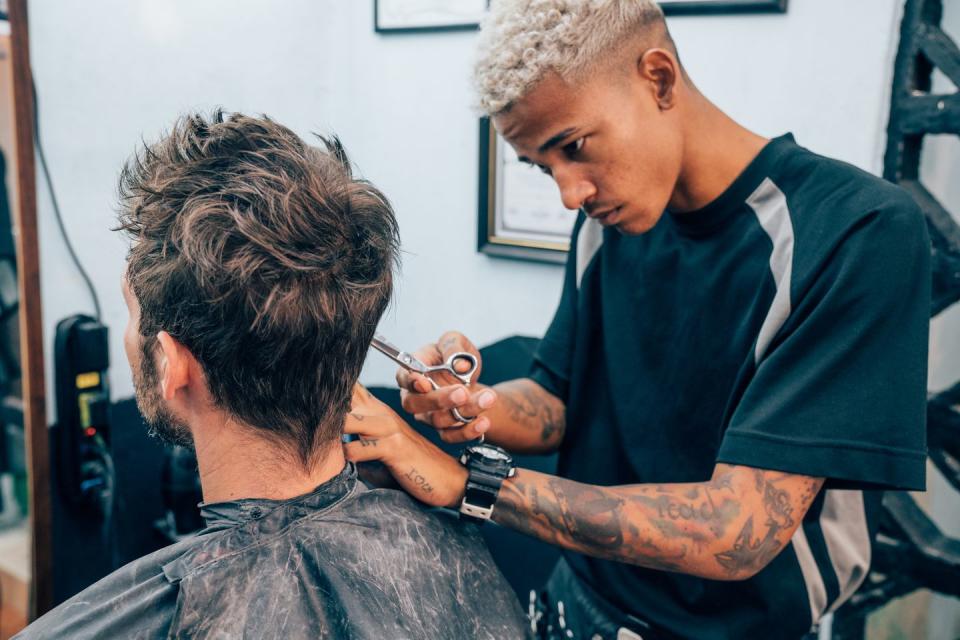How to Deal with a Receding Hairline

For the modern man, no grooming affliction is more visceral than the slow retreat of a receding hairline. It’s an experience shared by many; two-thirds of all men will be affected by male pattern baldness at some point in their lives, according to national charity The Men’s Health Forum, with around 7.4 million British men losing their hair at any one time.
A receding hairline can start creeping backwards any time after the end of puberty, and will usually become noticeable by the time most men reach their late 30s. At 40 years old, Jason Momoa – proud owner of one of the world’s most luscious lids – is very much the exception rather than the rule. Generally, thinning starts above the temples and ripples across the top of the head like a tsunami of bald, tearing down a portion of the 100,000 hairs on your scalp.
Hair Loss is Normal
Hair loss in itself is perfectly normal. Individual hairs fall out naturally, sometimes dozens each day, to be replaced with fresh ones – most of the time, says Tunc Tiryaki, consultant plastic surgeon at the Cadogan Clinic. However, if (or for most men, when) the hair follicle becomes damaged or decreases in size, “the growth cycle is hindered and the hair stops growing,” he explains.
As you age, oversensitivity in the scalp due to a hormone called dihydrotestosterone – or DHT – causes follicles to shrink, explains Dr Simran Deo, GP at UK-based online doctor Zava. “Your hair grows for a shorter length of time and the hairs that do grow become finer. In the end, the follicles that shrink will stop growing hair altogether – so when they shed hair as part of their natural cycle, new hairs don’t grow back in their place.”
What Accelerates a Receding Hairline?
Stress, anxiety, illness and even pollution are said to accelerate a receding hairline, says Tiryaki, though in those instances you can usually expect your mop to grow back. Smoking and drug use may also play a part, as well as your dinner choices – a sugar-rich junk food diet spells serious trouble for your lid.
When it comes to styling, going too hard on the heat can contribute to a receding hairline, as can tight hairstyles (man bun advocates, that means you) and colouring chemicals such as bleach and peroxide. So give the frosted tips a miss.

How a Receding Hairline is Diagnosed
For most men, a receding hairline is genetic – and therefore likely to occur regardless, says Dr Deo. “Hair loss is normally diagnosed by looking at the pattern of hair loss, your own medical history and also your family’s medical history,” he says. “A dermatologist can look to see how much your hair follicles have shrunk, or a GP can advise on treatment options.”
The Best Receding Hairline Haircuts
There’s no foolproof way to disguise a thinning thatch, and this is especially true upfront, so your first port of call should be your barber. Some hairstyles – such as an undercut, or a short back and sides – can actually give the appearance of a fuller head of hair, says Sam Hickey, head barber at Murdock London. “If you have a receding hairline or a very strong widows’ peak, don’t make it glaringly obvious by styling your hair backwards,” he says. “A slick-back or pompadour will only overemphasise a weak hairline.”
Instead, do the opposite and wear the hair forwards. “Try incorporating a fringe into your new style with either a longer, more relaxed mod-casuals cut (think BritPop and Madchester) or a super-sharp nineties-influenced crop with a box fringe,” Hickey continues. “Both styles are bang on trend and a lot more complimentary when your hairline has seen better days.” Just don’t go too extra with the fringe, he warns, or you risk being exposed by a chance gust of wind. Not a look.

How to Style Out a Receding Hair Line
When it comes to product, keep it simple. “Don’t use anything too thick, or tailored to wet looks,” Hickey says. “This can clump the hair together and make the hair look thin. We would recommend using dry hair styling products to help create a sense of fullness. You could also finish off with a light dusting of hairspray to secure extra hold throughout the day.”
This almost goes without saying, but if you’re blessed with robust natural facial hair, make the most of it with a strong beard or moustache. “This can easily detract from the visibility of a receding hairline and will soon become your pride and joy to grow and maintain,” he adds.
How to Stop Receding Hairlines
If your hairline has already set sail, not much can stop it – but that’s no reason to admit defeat. Read on for your options...
Receding Hairline Treatment: Supplements
If your receding hairline is down to a ropey diet, or you’re training hard without replenishing the right vitamins and minerals, hair growth supplements might be worth a shot. If you aren’t deficient, dosing up is unlikely to be the preventative measure or cure-all you’re looking for, warns Dr Deo. The way we see it, there’s no harm in trying. Here’s six essential vitamins that help your hair look healthy and full...
Vitamin A
All cells need vitamin A for growth, and hair is the fastest growing tissue in the body.
B Vitamins
B Vitamins help carry vital oxygen and nutrients to your follicles. Biotin is particularly important – the University of Nebraska-Lincoln linked biotin deficiency with hair loss in humans.
Vitamin C
Vitamin C creates collagen, protects your hair against oxidative stress and helps your body absorb hair-healthy iron.
Vitamin D
Research indicates that vitamin D has a role to play in creating new hair follicles. While the science isn’t quite understood, low levels are linked to alopecia.
Vitamin E
Like vitamin C, this powerful antioxidant helps prevent oxidative stress. In a Universiti Sains Malaysia study, people with hair loss experienced a 34.5 per cent increase in growth after supplementing with vitamin E for eight months.
Iron
Iron helps carry oxygen to the cells in your scalp – deficiency is a known cause of hair loss.
If your receding hairline has been caused by an underlying medical issue, “the most important thing to do is speak to your doctor,” advises Dr Deo. “As well as managing the condition, it’s likely that once the issue is resolved your hair will return to normal growth.”
Receding Hairline Treatment: Medication

If the problem is genetic, no number of GP visits and multivits will bring your forehead forwards. Should you be tempted to raid your local pharmacy for scalp-stimulating shampoos and topical creams, the most common over-the-counter medication for a receding hairline is called minidoxil, or Regaine, which increases the supply of blood and nutrients to the follicles and, in fairness, has been proven to work in several studies.
Alternatively, your GP can prescribe finasteride, or Propecia, which lowers levels of DHT – the hormone that causes your hair follicles to shrink. “It works by increasing the size of the follicle, increasing the number of hairs on the scalp, preventing further hair loss, thereby reversing the balding process,” Dr Deo explains. “It does not affect your body hair, and has been found to be effective in 9 out of 10 men.” The downside? Finasteride can take a while to kick in, and it only works while you’re taking it.
Receding Hairline Treatment: Surgical Techniques
If you’re seriously stressing about the state of your lid and can’t face the clean-shaven look – at least, not yet – receding hairline surgical treatments do exist. Some are more invasive than others and they’re all pretty costly, so make sure you do your homework before you commit.
Hair Transplant
During a hair transplant, a surgeon moves hair from the back of your head to the front, around the hairline, to give it a fuller appearance. There are two different methods: follicular unit transplantation (FUT), where a piece of your scalp is removed and repurposed, and follicular unit extraction (FUE), which sees individual follicles relocated. A single session can take four hours or more, and you might need three or four to achieve the look you’re going after. If it’s good enough for Rooney…
Stem Cell Treatment
Stem cell treatment doesn’t just prevent hair loss, it reverses it. Fat is harvested from your body using liposuction, mechanically separated and centrifuged to isolate the stem cells – which are then injected into your scalp. The procedure, which takes about 90 minutes, “harnesses the body’s natural regenerative mechanism”. Results are evident after a month, says Tiryaki, and continue developing over time.
Low Level Laser Therapy
Low-level laser therapy is a non-invasive, painless technique that uses lasers to invigorate circulation and stimulate hair growth. You’ll need several sessions a week for a number of months – and most providers suggest you continue treatments indefinitely.
If your receding hairline has been caused by an underlying medical issue, “the most important thing to do is speak to your doctor,” advises Dr Deo. “As well as managing the condition, it’s likely that once the issue is resolved your hair will return to normal growth.”
You Might Also Like

